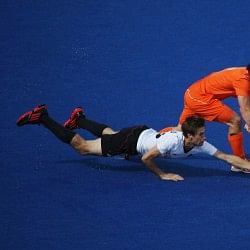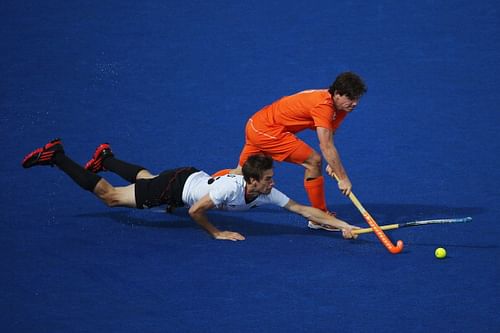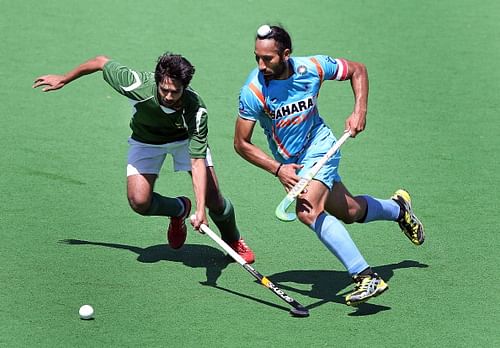
Blending age-old artistry and new physical skills: A casual chat with Pakistan Hockey captain Mohammed Imran

On a hot Sunday evening, March 31, 2013, during the ongoing Malaysian Hockey league, where Kuala Lumpur Hockey Club (KLHC) had convincingly defeated Nur Insafi club by a margin of 7 – 0, I had an opportunity to strike up a casual conversation with Mohammed Imran, captain of the current Pakistan hockey team, and now playing for the KLHC, who seemed to be in a good mood. Obviously, as his club team had just won!
Mind you, I am a complete stranger to this young man, as we were meeting for the first time. Here is how the conversation went.
“Mohammed, do you think that the silky skills of former Pakistani greats, Manzoor junior and Shabaz Ahmed, would be effectively applicable in today’s game?” I asked.
Mohammed promptly replied – even before I had completely finished asking the question – “No way; the game has changed and there is no place for those skills in today’s game.”
“Can you please elaborate on this point?”, I asked.
“See, the size of the field has increased, in fact doubled. Now we play between base line to base line, whereas in the earlier days, they used to play between 25 to 25″, he elaborated, while pointing towards the field, which was hardly more than 20 meters away from us and the league match between Club Sapura and Terengganu was in progress. Further, he added that the game had become very fast with the addition of the self pass and self goal.
Fair enough. I agree. Moreover, the players have also attained a higher level of fitness, which has lead to an extremely higher degree of individual work rate. No question about this.
I diverted the conversation from a Q & A one, into a one with leading questions.
I explained
- Yes there is a higher work rate
- Pace of the game has extremely increased
- Size of the field has increased
- Game has become more of a power play
But I strongly believe that there is a place for Manzoor Jr. and Shabaz Sr. and their “creative play making” skills in today’s game, as it will add more grace, creativity, excitement and finesse to the game.
I whispered this politely, as I did not want him to get annoyed with me, and walk away from a stranger whom he was meeting for the first time.
I looked at Mohammed’s face from the corner of my eye and could see the strange look on his face - sort of slightly fuming like a wounded tiger – and not being in a mood to carry on this conversation with a stranger. To keep him interested, I diverted his attention to his personal game by complimenting his playing style as a full back, as it was graceful and honestly I like it. I could see the change in his mood and he was being more receptive now.
After all, old Shivi has some tricks in his bag to keep the younger generation interested.
Thinking of the past, my mind flashed back to the final day of the Azlan Shah Cup, which had concluded exactly 2 weeks ago. This is a different story as while I was watching this Azlan Shah Cup qualification match for the 5 -6th spot position, I was day dreaming about the days when Pakistan and India used to meet for the gold medal match in the Olympics and World Cups. Now they are meeting for the wooden spoon match. How things change, if you don’t change with the times.
“It is not the strongest of the species that survive, nor the most intelligent, but the one most responsive to change.” – Charles Darwin
I am not trying to contradict myself, but one has to know what to change, discard, and what to retain. Here is where India and Pakistan went wrong. First, they were too rigid and took a long time to adapt to the latest tactics. Later, they went way over board and tried to completely imitate the European style and tactics and got caught in the middle, like a man with his feet in two boats.
Coming back to the present. All of a sudden, there was a long range pass – 60 to 65 meters – to the right-winger of the Sapura team, from his sweeper who was floating near his own circle. The RW received the ball and attempted to dodge his marker (the left-half), and while doing so, the ball crossed the base line, resulting in a free hit for the opponents. I asked Mohammed, “Do you think Kaleemulla would have wasted a the golden opportunity like this?” He would have cleanly eliminated his marker in a confined space and passed the ball to his leading center-forward, Hasan Sarder, to deflect the ball in the left corner/roof of the net.
Then, after a couple of minutes, the same thing happened on the left side, just near where we were sitting. The Sapura left-winger received a pass facing the gallery, and since his back was towards the attacking goal, I quietly whispered that nothing would happen. All of a sudden, there was a turn-over. I further commented that had Samiullah received that pass, he would have received the ball while facing the attacking goal, with his back towards us, and in seconds, he would have eliminated the half back and either entered the opponent’s circle or crossed the ball to Hasan to deflect it in the goal, probably near the right corner post or roof. It seemed that I had made my point clearly and Mohammed was nodding his head in agreement. Thanks Mohammed, for being understanding! After all, I tamed a tiger.
Yes, Samiullah, Kalleemullan, Hasan Sardar, Manzoor junior, and for that matter even Shabaz senior, would not have come back in defense to do back-checking, as much as one should. And this would have been suicidal in today’s game. As in earlier days, the players managed their energy wisely. Where as the current players don’t have a choice and have an extremely demanding role.

Conclusion:
Yes, the game has changed immensely and also improved tremendously in most departments. A sad part is that, along the way, we have not been able to maintain and execute the “1 on 1 effective offensive and defensive skills”, as mentioned above. This surely has taken away a certain degree of charm from our game, in a way making it less attractive and entertaining for the spectators. On the other hand, a shinning example is the way football and basketball has maintained their traditional technical and tactical skills, while building upon the physical and mental aspects of the game. They have moved in the right direction and we haven’t!
With all due respect, the tragedy is that FIH, and especially its Rules committee which had and continue to have the most brilliant brains of our game, have made way too many changes too fast. Some are good and some not so much, and this has affected our game in a negative way. The governing body of any sport has an obligation to maintain the tradition of the game – its core values – while seeking an optimum balance between “soft skills and power/speed – fitness – aspects” of the game, prior to recommending any changes. Unfortunately for field hockey, the changes that have been made over the years, in my humble opinion, have not done so, and taken away the emphasis of “creative soft skills” from the game. This has left us in a dire situation, making us wonder, what has happened and why did it happen?
Isn’t it true that we were in danger of being eradicated from the Olympics Games? We had a close shave. It is not over yet.
Solution:
Please treat the causes, and not the symptoms, if we want to see our game become more spectator-friendly and entertaining. Develop the creative soft skills of the young players in the junior programs. Let’s develop very many players of Sardar Singh and Jamie Dwyer‘s caliber and not just a couple, which is the case now.
I was talking to a 1976 Montreal Olympic Games coach (a couple of days ago) who had watched some international games on TV. Here are his honest views, “I wouldn’t pay a dime to go and see a current international match. It is so boring”. So sad, but so true!
• The paradox of our time in hockey is: we have more space on the field, but less game sense and soft skills to optimize its use
• We have performance analysis technology at our disposal: But we have difficulties in teaching our players the simple art of receiving the ball on the run and eliminating the opponent cleanly